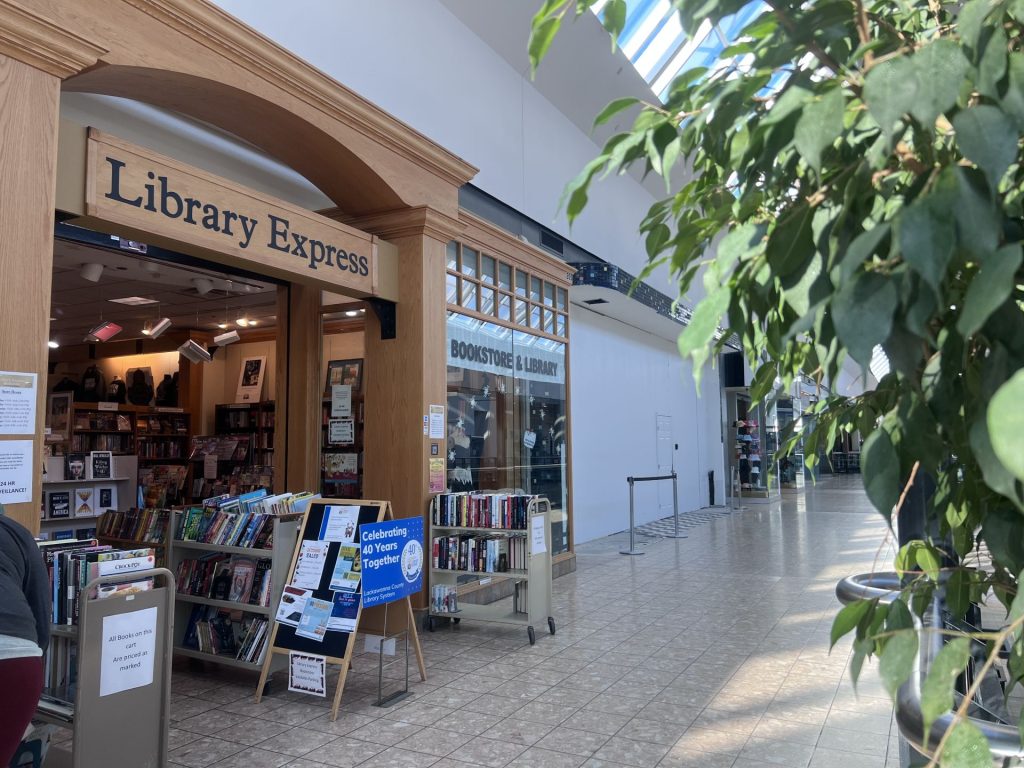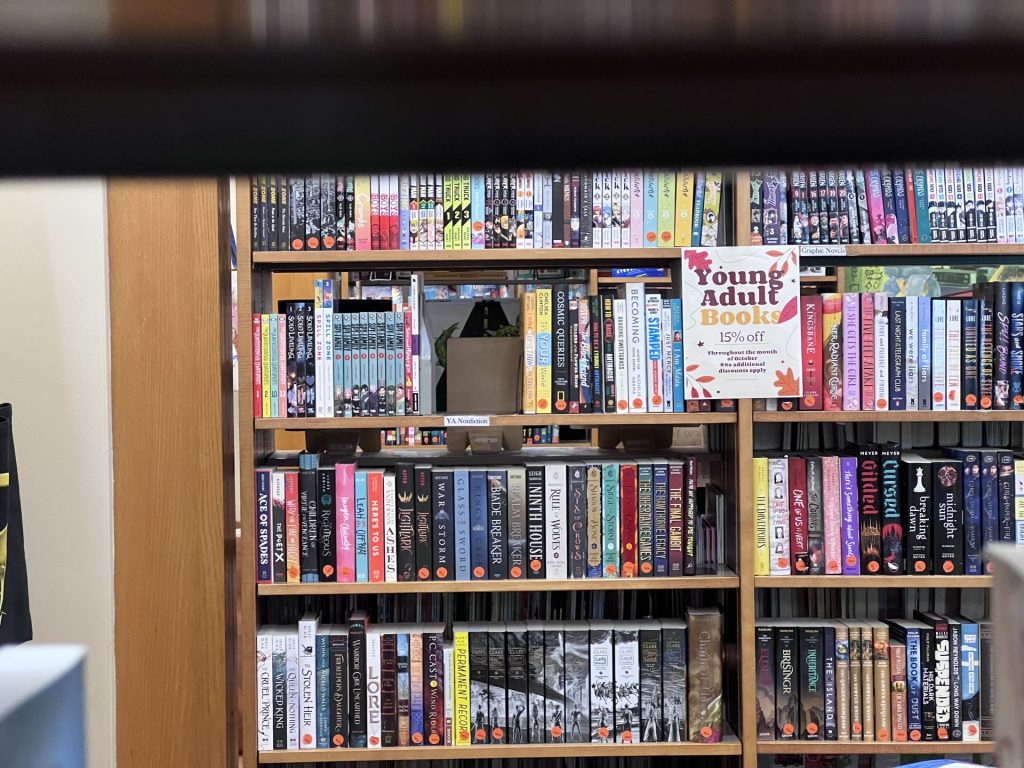Library Express: Creating a Library Feeling in a Consumer-Based World
The setup of Library Express is reminiscent of both the typical bookstore layout and the library it is modeled after. It intertwines aspects of a library that you would picture in any place with the distinct setup of a bookstore. Both aspects, while separate in theory, are tied together through the layout of the store. There is significance behind the placement and appearance of each section and decoration of Library Express. The setup of the front of the store, the purchasing area, is cluttered and full of books and book-related items that tempt customers into spending both their time and money in the store. The back of the store is a condensed version of a typical library, enough so that it is easy to forget you are also in a bookstore. This progression from store to library is well-paced and flows as it should. The overall layout of the store is clearly intended for independence. The calming music and general quiet of Library Express give everyone who enters a sense of solitude and peace that is much welcomed in the bustling world of today.
Despite this, the layout was more reminiscent of a bookstore than a library. There were only two sections with library-specific items, while the rest of the store was dedicated to purchasing items. The back end of the store was distinctly more library-centered than the front, which fits with the ideal library image. Libraries are typically quiet, private places where you can be alone in your thoughts. The placement of the community library areas at the back of Library Express allows more privacy. While there, you can feel as if you are in a different area than elsewhere in the store. If this area were at the front, the large windows would give a sense of being watched and exposed. You would never get the private sense that community requires.

The individual niches along the sides of the store were set up in a way that naturally progressed throughout. Each niche, though focused on a different subject, paired well with the surrounding niches. For example, the section on Scranton was next to the section on general history and reference books, which paired nicely with the facing artistic and poetry sections. This arrangement shows the great thought put into the set-up of the store. The designers thought about how people would progress while creating the layout. The entrance of the store, with bargain carts of books, suggests a feeling of intrigue in potential consumers. They see a variety of inexpensive books and themed window displays, which brings them into the store itself to encounter other temptations inside.

Though the library section was small, it was arranged in an almost exact match as the purchasing section of Library Express, making it easy to find books in either section. The two niches were separated by a container for returned library items, allowing it to be accessible to people on either side. In addition to this, the two niches on library materials were in the most isolated and private area of the store: the back corner. This mimics many other library setups in their separation from the rest of the world, which allows the customers to have a distinct idea of where they are. Allowing people to clearly know what the purpose of each section is allows them to find their way around without much outside assistance from employees. Their location next to the checkout, as well, lets the customers feel as if they are in a confined library. It eliminates the need to walk across the store through a different section with a different purpose.
Most items sold near the checkout area were book-themed, or at least book-adjacent. This perfectly reflects Lydia Pyne’s statement that “… the books and not-books a person puts on their shelves become a declaration of their identity” (41). The purpose of the store is to cater to bookish individuals and bring together a community. This is reflected in the specificity of books as a subject of most of the store. When you are next to the checkout area of any store, the small trinkets surrounding the register are meant to tempt you into spending just a bit more money. However, there was no pressure felt from the employees to purchase any of the items. The focus of the employees on creating an individual experience rather than spending money allows the store to mimic a library checkout experience.
The books themselves are shelved in a typical way, side by side with their spines out. The sales tables in the center of each niche are set up to maximize the space each book has. Each book on these tables is set apart from one another, propped up with their covers out, and arranged artfully on the shelves. This clear distinction forces the books on the tables to feel special, which tempts customers into purchasing them. The bookshelves themselves are wooden, with adjustable levels for each shelf. They do not have backing, which makes customers able to see through to the other side. This clarity between sections creates a small sense of community. You can see others participating in the same activity as you, which brings people together. Pyne states that “For some bookshelves, mobility involves arranging space for visitors. This arrangement of space is like creating spatial holes around the bookshelves” (64). The bookshelves, like Pyne’s idea of mobility, create individual spaces for customers to feel comfortingly confined in.
The sense of the store was one of isolated comfort, with a community available at any time. The employees never made their way around the store or even spoke with you beyond a greeting as you walked in the door. This action is reminiscent of a library, differentiating it from an otherwise consumer-based area, the mall. In libraries, the librarians do not walk around, and you are left to your own devices for the most part. However, in stores, you are forced to interact with employees and are asked if you require help at least once. This act, while innocuous, gives a distinct air that you are simply a customer rather than a member of a community, as opposed to the library sense.
It is obvious that Library Express caters itself toward community, especially in the wide variety of community-oriented sections. As Clifford says on page 221, “The critical history of collecting is concerned with what from the material world specific groups and individuals choose to preserve, value, and exchange.” Library Express collects books in a way that values their accessibility and wide audience, particularly shown in the clear and easy distinctions between areas. There are activity sections, book and stuffed animal pairs for children to peruse, a seating area, and an open activity for customers to color themselves. With the confined area of the back of the store, people in those areas are more likely to feel a sense of community with others, as they are all in the same space participating in the same activity. Though this activity is not always the exact same, the location and similarities in activities are enough. Library Express and its setup tie together into a close-knit community welcoming to all.
Images
Nelson, Brooke. Images of Library Express. 28 Oct. 2023.
Sources
Clifford, James. “On Collecting Art and Culture.” Harvard University Press, 1988, pp. 215–251. Twentieth-Century Ethnography, Literature, and Art, Accessed 1 Nov. 2023.
Pyne, Lydia V. Bookshelf. Bloomsbury Academic, an Imprint of Bloomsbury Publishing Inc., 2016.

0 Comments